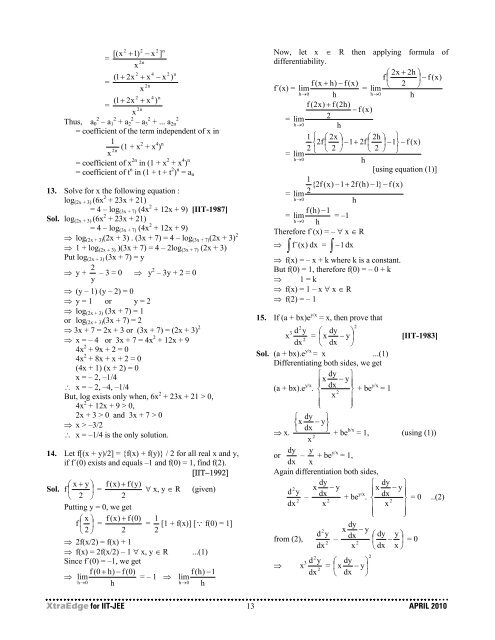Solution - Career Point
Solution - Career Point
Solution - Career Point
Create successful ePaper yourself
Turn your PDF publications into a flip-book with our unique Google optimized e-Paper software.
2 2 2 n[( x + 1) − x ]=2nx2 41+2x + x=2n2 4 n( 1+2x + x )=2n2( − x )xxThus, a 2 0 – a 2 1 + a 2 2 – a 2 23 + ... a 2n= coefficient of the term independent of x in12n (1 + x 2 + x 4 ) nx= coefficient of x 2n in (1 + x 2 + x 4 ) n= coefficient of t n in (1 + t + t 2 ) n = a n13. Solve for x the following equation :log (2x + 3) (6x 2 + 23x + 21)= 4 – log (3x + 7) (4x 2 + 12x + 9) [IIT-1987]Sol. log (2x + 3) (6x 2 + 23x + 21)= 4 – log (3x + 7) (4x 2 + 12x + 9)⇒ log (2x + 3) (2x + 3) . (3x + 7) = 4 – log (3x + 7) (2x + 3) 2⇒ 1 + log (2x + 3) )(3x + 7) = 4 – 2log (3x + 7) (2x + 3)Put log (2x + 3) (3x + 7) = y⇒ y + y2 – 3 = 0 ⇒ y 2 – 3y + 2 = 0⇒ (y – 1) (y – 2) = 0⇒ y = 1 or y = 2⇒ log (2x + 3) (3x + 7) = 1or log (2x + 3) (3x + 7) = 2⇒ 3x + 7 = 2x + 3 or (3x + 7) = (2x + 3) 2⇒ x = – 4 or 3x + 7 = 4x 2 + 12x + 94x 2 + 9x + 2 = 04x 2 + 8x + x + 2 = 0(4x + 1) (x + 2) = 0x = – 2, –1/4∴ x = – 2, –4, –1/4But, log exists only when, 6x 2 + 23x + 21 > 0,4x 2 + 12x + 9 > 0,2x + 3 > 0 and 3x + 7 > 0⇒ x > –3/2∴ x = –1/4 is the only solution.14. Let f[(x + y)/2] = {f(x) + f(y)} / 2 for all real x and y,if f´(0) exists and equals –1 and f(0) = 1, find f(2).[ΙΙΤ−1992]⎛ x + y ⎞ f (x) + f (y)Sol. f ⎜ ⎟ =⎝ 2 ⎠ 2∀ x, y ∈ R (given)Putting y = 0, we get⎛ x ⎞ f (x) + f (0)f⎜⎟ =⎝ 2 ⎠ 21= [1 + f(x)] [Q f(0) = 1]2⇒ 2f(x/2) = f(x) + 1⇒ f(x) = 2f(x/2) – 1 ∀ x, y ∈ R ...(1)Since f´(0) = –1, we getf (0 + h) − f (0)f (h) −1⇒ lim = – 1 ⇒ limh → 0 hh → 0 hnNow, let x ∈ R then applying formula ofdifferentiability.⎛ 2x + 2h ⎞f ⎜ ⎟ − f (x)f (x + h) − f (x)2f´(x) = lim = lim⎝ ⎠h → 0 hh→0hf (2x) + f (2h)− f (x)= lim2h→0h1 ⎧ ⎛ 2x ⎞ ⎛ 2h ⎞ ⎫⎨2f⎜ ⎟ −1+2f ⎜ ⎟ −1⎬− f (x)2 2 2= lim⎩ ⎝ ⎠ ⎝ ⎠ ⎭h → 0h[using equation (1)]1{2f (x) –1+2f (h) −1}− f (x)= lim 2h→0hf (h) −1= lim = –1h → 0 hTherefore f´(x) = – ∀ x ∈ R⇒∫f´(x)dx =∫−1 dx⇒ f(x) = – x + k where k is a constant.But f(0) = 1, therefore f(0) = – 0 + k⇒ 1 = k⇒ f(x) = 1 – x ∀ x ∈ R⇒ f(2) = – 115. If (a + bx)e y/x = x, then prove thatx 3 2d y ⎛ dy ⎞= ⎜ x − y⎟ [IIT-1983]2dx ⎝ dx ⎠Sol. (a + bx).e y/x = x ...(1)Differentiating both sides, we get⎧ dy ⎫⎪x− y ⎪(a + bx).e y/x .dx⎨ ⎬ + be y/x = 12⎪ x ⎪⎩⎭⎧ dy ⎫⎨x− y⎬dx⇒ x.⎩ ⎭+ be b/x = 1, (using (1))2xdy yor – + be y/x = 1,dx xAgain differentiation both sides,dy⎧ dy ⎫2 x − yd y–dx⎪x− y ⎪+ be y/x .dx22⎨ ⎬ = 0 ..(2)2dx x⎪ x ⎪⎩⎭dy2 x − yd yfrom (2), –dx ⎛ dy y ⎞22⎜ − ⎟ = 0dx x ⎝ dx x ⎠⇒ x 3 2d y ⎛ dy ⎞= ⎜ x − y⎟ 2dx ⎝ dx ⎠22XtraEdge for IIT-JEE 13 APRIL 2010
















